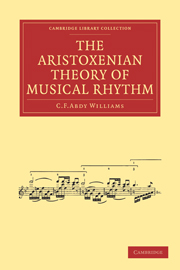Book contents
- Frontmatter
- PREFACE
- Contents
- MUSICAL ILLUSTRATIONS
- INTRODUCTION
- CHAPTER I
- CHAPTER II
- CHAPTER III
- CHAPTER IV
- CHAPTER V
- CHAPTER VI
- CHAPTER VII
- CHAPTER VIII
- CHAPTER IX
- CHAPTER X
- APPENDIX A Quotations, from original sources, of passages referred to in the text
- APPENDIX B Glossary of Technical Terms
- APPENDIX C Dactylo-epitritic, Logaœdic, and Dochmiac rhythms, and rhythmical modulation. M. Laloy's views
- INDEX
- Frontmatter
- PREFACE
- Contents
- MUSICAL ILLUSTRATIONS
- INTRODUCTION
- CHAPTER I
- CHAPTER II
- CHAPTER III
- CHAPTER IV
- CHAPTER V
- CHAPTER VI
- CHAPTER VII
- CHAPTER VIII
- CHAPTER IX
- CHAPTER X
- APPENDIX A Quotations, from original sources, of passages referred to in the text
- APPENDIX B Glossary of Technical Terms
- APPENDIX C Dactylo-epitritic, Logaœdic, and Dochmiac rhythms, and rhythmical modulation. M. Laloy's views
- INDEX
Summary
The word “rhythm,” like most other musical terms, is used by the Greeks in more than one sense. This would cause them no more difficulty than our own terms give us. For example, when we meet with the word “note” in a modern musical treatise, we know by the context whether it signifies a particular sound, or the sign by which that sound is indicated in writing, or the key of the pianoforte that corresponds to the sound and written sign. All three things are equally designated as “note” by us, and it is conceivable that when, in some two thousand years time, English, German or French shall have become dead languages, and the then living people wish to learn something of our musical art from fragmentary treatises, they may find words with more than one technical signification a little perplexing.
The term rhythm is applied in three ways: (1) in the sense already explained in Chapter III; (2) a single foot is sometimes called a rhythm; and (3) a whole phrase or sentence is called a rhythm.
Likewise the two words chromos and pous, meaning, respectively, time and foot, are each applied in several ways. Primary time is by now familiar to the reader. But Aristoxenus and Aristides apply the word chromos to the thesis and arsis, respectively, of a foot, and again to a group of feet, and, further, to the whole phrase.
- Type
- Chapter
- Information
- The Aristoxenian Theory of Musical Rhythm , pp. 49 - 69Publisher: Cambridge University PressPrint publication year: 2009First published in: 1911



